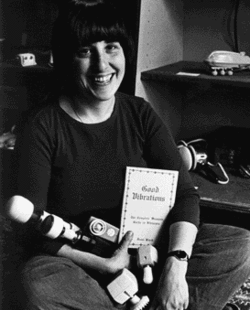Feminist Sex Toy Inventors
Looking at early vibrators—many of which look more like instruments of torture than pleasure-aids—the argument for women inventors really writes itself. Developing sex toys for women is itself a feminist act: a proclamation that women deserve to have orgasms and enjoyable sex, with or without partners. Joani Blank, the founder of the nation’s first woman-friendly, sex-positive “adult” store, was also a vibrator inventor. Today, Alexandra Fine and Janet Lieberman are taking up her mantle and bringing vibrators to buzzy new heights.
Vibrators were invented by men—unless you believe the legend that Cleopatra created the first vibrator by filling a gourd with angry bees.
By the mid-19th century, “hysteria” was a common diagnosis for women suffering from anxiety, sleeplessness, irritability, depression, nervousness, erotic fantasies, and feelings of “heaviness” in the lower abdomen. Today, we’d call this “sexual frustration.” Doctors on a quest to relieve symptoms of hysteria began massaging the genitals of female patients. Lo and behold, many women reported relief from their “hysteria” and began calling on their doctors regularly, which presented these medical professionals with new problems like hand cramping and arm exhaustion.
And so the vibrator was born as a way to save doctors from having to give hand jobs to their female patients.
This rather comic, highly unlikely history of the vibrator is something that Joani Blank knows a thing or two about. Before founding the feminist sex-toy store Good Vibrations in 1977, Blank had begun collecting vintage vibrators. In fact, Good Vibrations was in part created to showcase her collection, which she’d been keeping under her bed in a suitcase. Today, the Polk Street location of Good Vibrations in San Francisco houses the Antique Vibrator Museum.
Even before learning about the evolution of vibrators and the diverse ways in which women use sex toys, Blank saw the need for a hands-free vibrator and began developing her own device—a strap on model called The Butterfly.
The Butterfly is a non-penetrative clitoral stimulator now made of soft silicone. (in 1977, vibrators were still made of hard plastic). In considering what makes a sex toy “feminist,” one that doesn’t mimic the shape of a penis seems like a good start. There is liberation in the invention of a vibrator that is round and flat rather than cylindrical—modeled to go on the vulva and not into the vagina.
Through decades as a sex educator, activist, author, and entrepreneur, Joani Blank has proved the vital importance of “adult” stores geared to women and diverse, woman-centric sex toys: Good Vibrations now has eight locations and a popular website, and the Butterfly is still widely available for purchase. Promising orgasms instead of medical solutions, Blank ushered in the end of an era of obfuscation and secrecy around vibrators and female masturbation.
Thankfully, it’s no longer 1977, when Blank’s decision to sell sex toys in a well-lit, education-oriented store was a radical act. But toys made by women, for women are still difficult to find. Today, at least one third of American women own a vibrator, and Alexandra Fine and Janet Leiberman are aiming to produce more satisfied customers with their invention, Eva.
Thanks in large part to Joani Blank, masturbation has been demystified, and orgasms are attainable for most women who are willing to spend some time shopping for vibrators. But evening the sexual playing field remains an issue, particularly for heterosexual couples: men tend to orgasm more quickly than women, at which point sexual play often ends. According to the Kinsey Institute, 70% of women need clitoral rather than internal stimulation to orgasm. For many women, not being able to orgasm during intercourse remains frustrating—and that’s where Alexandra Fine and Janet Lieberman come in.
Eva boasts a perfectly millennial backstory: Fine wanted to invent a sex toy that prioritized women’s physiology, something that could help women enjoy sex without getting in the way or needing to be held in place by hands or straps. She met Lieberman, an MIT-trained mechanical engineer, and the two joined forces to form Dame Products. Eva, their first toy, was funded through an online Indiegogo campaign. Like the Butterfly, it’s wearable, but it does away with straps and fits under a woman's labia majora, directly over the clitoris. Non-penetrative and discreet, it is a couples’ vibrator, meant for use during intercourse.
Fine and Lieberman’s success suggests that women are eager for more options when it comes to sexual stimulation and willing to engage their partners in trying sex toys. Gone is the antiquated notion that vibrators “replace” men, or that women who own vibrators will scare off potential partners.
If 1970s feminism meant giving women a voice and 2010s feminism has focused on leveling up, these vibrators are perfect encapsulations of each era’s feminism. With the Butterfly, Joani Blank made women’s pleasure accessible without phallocentric sex, and with Eva Alexandra Fine and Janet Lieberman encourage women to ask more from sex—and from the people they have it with.




